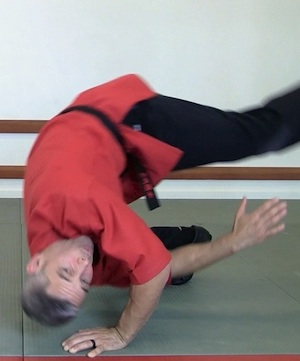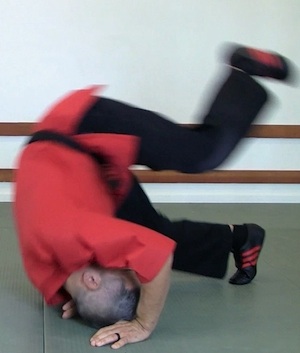Forward rolls in the martial arts are taught a lot of different ways…
You might see the lead hand cutting across the hip or through the legs, for example.
You might also see the back hand cutting across the hip or through the legs. Or maybe both arms are extended.
Which is right?
For me, if you’re practicing shoulder rolls for self-defense and not just to look cool, the answer is simple. And I share that answer in the video below.
If the video doesn’t play, scroll down for a summary. Either way, keep rolling! 🙂
How to Practice Forward Rolls for Self-Defense
The basics of shoulder rolls instruction are usually the same everywhere you go—
- Tuck your chin
- Exhale.
- Stay soft.
- Avoid driving any bone into the ground.
But how should you position your arms?
When it comes to self-defense training, the most important thing to remember when you’re rolling is to protect your head. Actually, that’s always the most thing to remember. Why?
Because if the ground hits your head, a bad guy hits your head, or anything hits your head, you might get knocked out. Fight over. Maybe even life over.
That’s why I always keep my hands—both hands—by my head when I roll.
Even outside of a self-defense situation, I would still make protecting my head my number one priority. I talk about that a little more in, 3 Martial Arts Moves You Can Do Every Day.
But for now, imagine you get sucker punched in a bar, or fall down a flight of stairs, or get thrown out of a moving car…

Does it makes any sense to suddenly drop one arm through your legs? Or sticking it out to the side? No! Dropping your guard is a good way to get your arm broken or head smashed in.
Rolling on the ground should be approached the same way as fighting on your feet. If you’re on your feet getting punched in the head, would you ever drop your guard? Of course not. So, don’t do it on the ground, either.

Of course, there is more to practicing falls or ukemi than just looking cool. If you get caught in a jointlock, a forward roll or backward roll might be your only means of escape. You roll to preserve your joint.
That’s fine! I do that all the time! The mistake, however, is thinking that you always have to roll like that.
Whether you’re defending yourself against a striker or a grappler, building a habit of sticking your head or arm out when you don’t need to opens you up to the risk of never getting those body parts back again.
The point is to always remember that you are training for self-defense, not a gymnastics competition. So, don’t give away your limbs. If the bad guy wants them, he needs to take them.
Shoulder Roll Drill
If you’re not sure if the way you roll is suitable for self-defense, here’s a simple drill to find out.
Step 1: Warm up.
Forward roll across the room, then backward roll back again. Feel good? Great!
Step 2: Find a training partner.
Repeat the same rolls back and forth across the room, but this time ask your training partner to try and punch, kick, and knee you in the head. If you like, try to get up to your feet, too.
Try it! I promise—this one drill will teach you everything you need to know about rolling for self-defense.
Happy rolling!

You can’t just not say something about break falls when you’re talking about rolling! 🙂
Ha! Sorry about that. I have lots to say about break falls… just trying to figure out how to say it in a 5-minute video.
In short, I think break falls are widely misunderstood and misused.
Thanks for keeping me honest, sir!
I just figured if falling from a standing position something must come before the roll. Right? Personally I’ve never been knocked to the ground so I’m just asking for those that have that didn’t speak up. Heh
Seriously tho… I only know the traditional slap the ground with arms splayed. Must be a better way. I’ll patiently wait for that specific topic.
With very few exceptions, I’m not a big fan of slapping the ground. I can make my case more easily on video, so thanks for the nudge to move that up my “to-do” list.
For now, though, my answer is nah… you don’t need to slap the ground when falling backwards. Most of the time. 🙂
Ossu! Thank you! I’ll have to incorporate protecting my head into my rolls.
Yes! Please do! 🙂
The video clip makes sense, however as Shawn mentioned it looks like we’re looking at two different things rolls vs breakfalls.
My understanding is that regarding breakfalls, a roll is simply a continuation of a breakfall, so the way I’ve been taught and continue to practice is to slap the arm on the ground to absorb the force of the fall.
With rolling itself, it’s merely a way to get around so in that case no need to stick the arms out to absorb the force.
Eitherway, the ideas expressed in the video are worth trying out and incorporating …
Welcome, sir! Thanks for the comment.
There’s a time and place for everything, so if slapping helps you survive a fall or ease into a roll, so be it. Do what you do!
I’ll be back with a video to explain what I’m talking about. Until then, rock ‘n’ roll!
My general understanding is that you should generally prefer rolling over break-falling, but that depends on the situation. Rolling distributes the force better and can get you far from an attacker (also, you can steer yourself in your roll to go forward, left, or right, and can adjust to go further or shorter, as well as roll multiple times as you need). Of course, rolling into a wall or into the street would be bad and there are some environments where you are too constrained to roll, as compared to just going relatively straight down, in which case you’d break-fall.
I don’t know how you’d go from a break-fall to a roll — the mechanics are fairly different. In one you want to be straight as an arrow, with your arms and body tense to absorb the impact; in the other you want to be curled up and relaxed so that you roll, rather than slap the ground with your body. This is even more true with a forward roll and forward break-fall, where in the one your arms need to be locked into place, your face to the side, and body tight and straight, but it does also apply to the back and side break-falls verse the complementary rolls. Also, with a forward roll, you’ll break your shoulder really badly if you try to convert from a forward break-fall to a forward roll too late in the game, so I’m still a bit unsure about how one can safely convert on concrete.
Thanks for the thoughtful comment.
There are many different speeds and angles you can fall or be thrown to the ground. Your body can also be in many different positions or holds. So, while it’s convenient to divide falling into rolling or break falls, there are times when the lines blur. All I’m saying is that no matter how you fall, protecting your head should always be the first priority.
Looking forward to it 😉
Me, too! 🙂
Thanks for rolling for love! Great drill ideas and I can definitely use these in classes. I was always told to not put the hands down first unless you want to break them (or your wrists)…what are your thoughts on that? Great Job Sensei Ando!
Thanks for dropping by, Andrea! 🙂
You can fall at many different angles, speeds, and on different surfaces… so you might also find yourself rolling in different ways. In general, though, using the hands to negotiate a fall is NOT a problem so long as they are absorbing the fall and not trying to STOP it. When people stick out their arms out of fear, they are prone to injury. But if you accept what’s happening and literally roll with it, you should be just fine.
All I can say is that I’ve taken thousands of falls and never hurt my wrists… but I have separated my shoulder when I didn’t use my hands! Hopefully, we can trade notes on this in person… it’s easier! Keep rollin’, Martial Arts Woman! 🙂
You might want to talk about how parkour traceurs do it; their preferred arm placements and adjustments. While they aren’t martial artists, how they apply forward rolls when falling from height (and immediately run off) may give insight for us as martial artists.
At least, this is the closest thing I can think of to a self-defense situation – to fall and get back up (or run) immediately – in the most efficient way.
And I am looking forward to the follow up – Break falls.
Cheers, Ando!
Hi Logen!
Yes, the parkour crowd definitely knows something about hitting the ground safely! Of course, when it comes to self-defense, it’s not just the impact on the ground that matters, it’s protecting your head from punches and kicks at the same time. That’s what makes us martial artists so darned special! 🙂 Thanks for dropping by!
So it seems as though you are talking about two and 1/2 different concepts(?): Rolling vs. Break-Falling (but there is also rolling _into_ a break-fall; as I understand it, the rolls and break-fall training we did in Judo were two parts of the same thing– the best way to deal with getting thrown or flipped).
So when would you roll vs. break-falling? Or would you ever apply a break-fall? I’d look forward to a follow-up video. Incidentally, the break-falling I learned in Judo was _very_ different from the break-falling I tried to grasp when taking Systema classes. More than one way to skin a rolling cat, I suppose, but I definitely prefer the Judo approach…
G.
H Gregg! Always happy to hear from you!
Interesting to hear about your Judo and Systema experiences… I started taking private Systema lessons not too long ago and have enjoyed exploring the alternative points of view on many issues.
My main point about break falls is that most people use them when they don’t need to… or shouldn’t! If I have my hands on a bad guy, I’m going to hang on to the bad guy. Letting go and turning away during a fall are both bad ideas. That will be the thrust of the video.
To me, break falls are better suited for falling off ladders and… well, that’s about it! 🙂
Thanks for reminding me to shot that video. I just need to find someone who wants to throw me on camera! Keep fighting, sir!